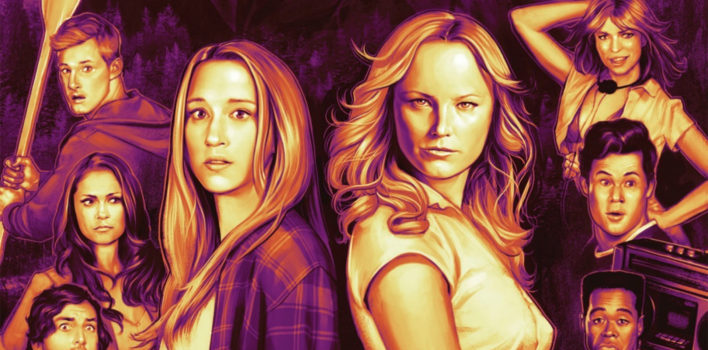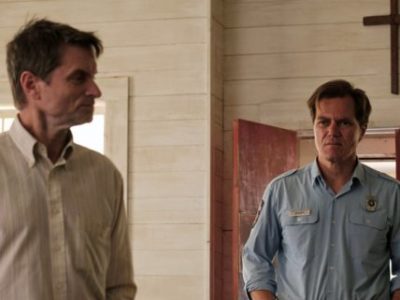Oh! The Horror… | of Deconstructing the Heart of the Slasher Genre
Greater love has no one than this, that someone lay down his life for his friends.
— John 15:13 (ESVUK)
I just thought what was so clever about the conceit of the movie is that it really is the story of a mother and a daughter, a second chance, and the reverbs of a loss like that in the middle of a genre that doesn’t take that very seriously. I thought that was a really f—–g smart idea. So almost in a way — and I would never compare myself to him ever in a million years — but almost in a way in the same way that Tarantino uses genre to like move along a different agenda, we’re sort of doing the same thing. We’re cloaking a story in horror to push the emotional story along.
— Todd Strauss-Schulson (dir. of The Final Girls), interviewed on Hitfix.com
 Deconstructions of the slasher sub-genre have gone all the way back to 1981’s Student Bodies and have found perennial incarnations in both the good (Scream franchise) and the less enthralling (Scary Movie franchise) forms. These types of deconstructive films usually find their momentum through comedic forms, especially when it comes to the act of deconstructing horror. The point of movies like Scream, Scary Movie and The Final Girls is to unearth the inherent absurdity of their particular sub-genre’s tropes. What separates good from bad is how intelligently they are able to subvert those absurdities. The Final Girls may be the best deconstruction of the slasher genre I have seen since Scream. I might even go so far as to say that it is the better film–and, trust me, I don’t take such claims lightly considering how brilliant I found Wes Craven to be as a director.
Deconstructions of the slasher sub-genre have gone all the way back to 1981’s Student Bodies and have found perennial incarnations in both the good (Scream franchise) and the less enthralling (Scary Movie franchise) forms. These types of deconstructive films usually find their momentum through comedic forms, especially when it comes to the act of deconstructing horror. The point of movies like Scream, Scary Movie and The Final Girls is to unearth the inherent absurdity of their particular sub-genre’s tropes. What separates good from bad is how intelligently they are able to subvert those absurdities. The Final Girls may be the best deconstruction of the slasher genre I have seen since Scream. I might even go so far as to say that it is the better film–and, trust me, I don’t take such claims lightly considering how brilliant I found Wes Craven to be as a director.
Scream did not come rolling into it’s meta-narrative with guns blazing like the film-within-film-within-film regression of 1993’s Last Action Hero, instead it chose to comment on slashers by placing its characters within a world where slasher films exist. While Scream‘s formal setup would lend itself to more subtlety in its commentary on slasher films, the self-awareness in its characters actually comes off a bit blatant and hammy, at times, which all-to-often–especially in later films in the series–shows its cards too easily. Regardless of this, the Scream franchise, on the whole, still does the heavy lifting of deconstruction and makes for entertaining and quite funny films.
The formal setup of The Final Girls‘ narrative has that in-your-face, guns-blazing meta-narrative stroke ripped directly from Last Action Hero, among others, which, from the outset, does not strike the audience as promising for the duration of the film. However, once past the point where the five characters find themselves within the slasher film, the script becomes very subtle in its deconstruction of the sub-genre. Where Scream relied more on character exposition to subvert tropes, The Final Girls relies on visual description and dialogue and developed relationships between characters to do the heavy lifting. Fortin and Miller, the screenwriters, did not need exposition because they were able to show instead of tell the audience what is absurd about slasher tropes.
What does this mean in comparison to Scream? I think it means The Final Girls ends up not being near as funny of a film as Scream, but, instead, it is aiming for something more than just detached deconstruction of the sub-genre. It is aiming to find the emotional heart within the cold bleakness of slasher films. As I have written elsewhere, the created worlds of the slasher genre is one where grace and mercy are nonexistent luxuries. They are worlds that run on the dark side of karma: no one is totally innocent, everyone must, then, die, even the “pure and virginal” final girls in many of the slasher sequels.
 Many people in American/Western culture accept karmic constructions subconsciously in their lives, politics and relationships. Add to this our penchant for affirming the inherent goodness of humanity–something that is subtly selfish: people are inherently good, so I can truly believe I am good and not capable of doing the things I see others do–it is easy to see where our society’s merciful and compassionate core has crumbled. Slasher films are actually subverting society’s cult of positivity by culling the depths of ancient moral systems that one would find in the Hebrew Mosaic Law.
Many people in American/Western culture accept karmic constructions subconsciously in their lives, politics and relationships. Add to this our penchant for affirming the inherent goodness of humanity–something that is subtly selfish: people are inherently good, so I can truly believe I am good and not capable of doing the things I see others do–it is easy to see where our society’s merciful and compassionate core has crumbled. Slasher films are actually subverting society’s cult of positivity by culling the depths of ancient moral systems that one would find in the Hebrew Mosaic Law.
If we look at the nature of the Mosaic Law in the Old Testament, it is, on the surface, very karmic: if you do ____, then you will receive ____. According to the Hebrews, God’s Law is good and perfect. The problem comes when broken humans attempt to live up to the good and perfect Law. It can’t be done. Even if we outwardly live up to the Law, the internal motivations call out our hypocrisy. God’s Law points out our brokenness and our inability to attain our goal to be gods–which is a central point of the story in the Garden of Eden. The Law convicts us and forces us to look at ourselves in our actuality, scales fallen away from our eyes. Slasher villains are the figurative Law in the universe of slasher films. Their presence is felt, they seem to be everywhere and they are after us. The weapons they wield against us are the analogical death knell of the Law on our curated and constructed selves. The slasher sees nothing but guilt and shows no mercy in the face of that perception. Guilt deserves death in the world of the slasher…and in the world of the Hebrew people.
There is an added profundity (and social commentary) within the realm of The Final Girls in that the movement of the narrative and meaning behind the film is dependent on the strength of its largely female cast. The men in the film are merely there for comedic effect or as, rather unimportant, love interests. Ultimately, the gender roles are reversed from the typical slasher film, except for the final girl. The strength of the film lies in these characterizations and the relational dynamics between the female characters. Even the climactic moment of the film, with all of its profound meaning in tow, is imparted by the female characters, not the typical man saving the woman stereotype. This film is concerned with women saving other women…and the occasional man.
The beauty of The Final Girls‘ final act which centers around the relationship between Max and her mother, Amanda–who plays Nancy in the slasher film they find themselves in–is that it provides the incarnation of sacrifice and mercy into a sub-genre that is largely devoid of such concepts.
 We come to the climax where the slasher, Billy Murphy, has successfully dispatched everyone except Nancy, Max and Chris–though both Max and Chris have been injured–Nancy and Max are facing the truth of the slasher trope of the final girl; only one pure, virginal girl can survive the slasher’s rampage. Max wants to die so that her mother can survive and Nancy/Amanda wants to save her friend/daughter by dying. At that moment, the two persons, Nancy and Amanda, become one in their will to save Max by giving up their body to the force of the slasher villain…the Law and its demands.
We come to the climax where the slasher, Billy Murphy, has successfully dispatched everyone except Nancy, Max and Chris–though both Max and Chris have been injured–Nancy and Max are facing the truth of the slasher trope of the final girl; only one pure, virginal girl can survive the slasher’s rampage. Max wants to die so that her mother can survive and Nancy/Amanda wants to save her friend/daughter by dying. At that moment, the two persons, Nancy and Amanda, become one in their will to save Max by giving up their body to the force of the slasher villain…the Law and its demands.
In a truly touching and profound moment in the film, Nancy walks out of the church where Max and Chris are lying, injured, and offers herself up to Billy Murphy while Kim Carne’s 1981 hit, “Bette Davis Eyes,” plays in the background, providing the soundtrack for an untamed, fully human, but strangely otherworldly pop savior. Both a beautiful and unnerving embodiment:
Her hair is Harlowe gold
Her lips sweet surprise
Her hands are never cold
She’s got Bette Davis eyes
She’ll turn her music on you
You won’t have to think twice
She’s pure as New York snow
She got Bette Davis eyesAnd she’ll tease you
She’ll unease you
All the better just to please you
She’s precocious and she knows just
What it takes to make a pro blush
She got Greta Garbo stand off sighs
She’s got Bette Davis eyes
Much like the myth–and I use this term in the vein of CS Lewis and not the modern meaning–of the God-man who came into the world and sacrificed his own body to the demands of the Law in our place, even though he was innocent, so does Nancy, who was innocent in the realm of the slasher world, willingly (and out of love for Max) gives her body up to Billy Murphy, so that Max might live. And so it happens, the cinematic analogue of the Biblical lamb to the slaughter. An epically shot scene set to a song that uncovers the heart behind the film, one that illuminates the profound nature of relationships between women whether mother/daughter or friendship. A mother’s sacrifice both saves her daughter’s life and allows for her daughter to then live in the wake of that moment of mercy and grace. Cinematic moments like this remind us of the power of the Christ imagery even if one does not explicitly place their faith in the truth claims that bolster that imagery.
 It has been a while since a film has affected me in such a way that it burns itself into my subconscious and gives me a new visual language to help me both appreciate the sub-genre it belongs to and comments on while giving me a new lens to imagine the depths of the content of my faith.
It has been a while since a film has affected me in such a way that it burns itself into my subconscious and gives me a new visual language to help me both appreciate the sub-genre it belongs to and comments on while giving me a new lens to imagine the depths of the content of my faith.
The Final Girls delivers on its subtle deconstruction of the slasher by subverting its misogynistic edge by making women the key movers of the narrative’s tension and release and finding the heart inherent in the slasher by illuminating the sacrificial love of mothers for daughters and women for their female friends.







